Page 290 of 350
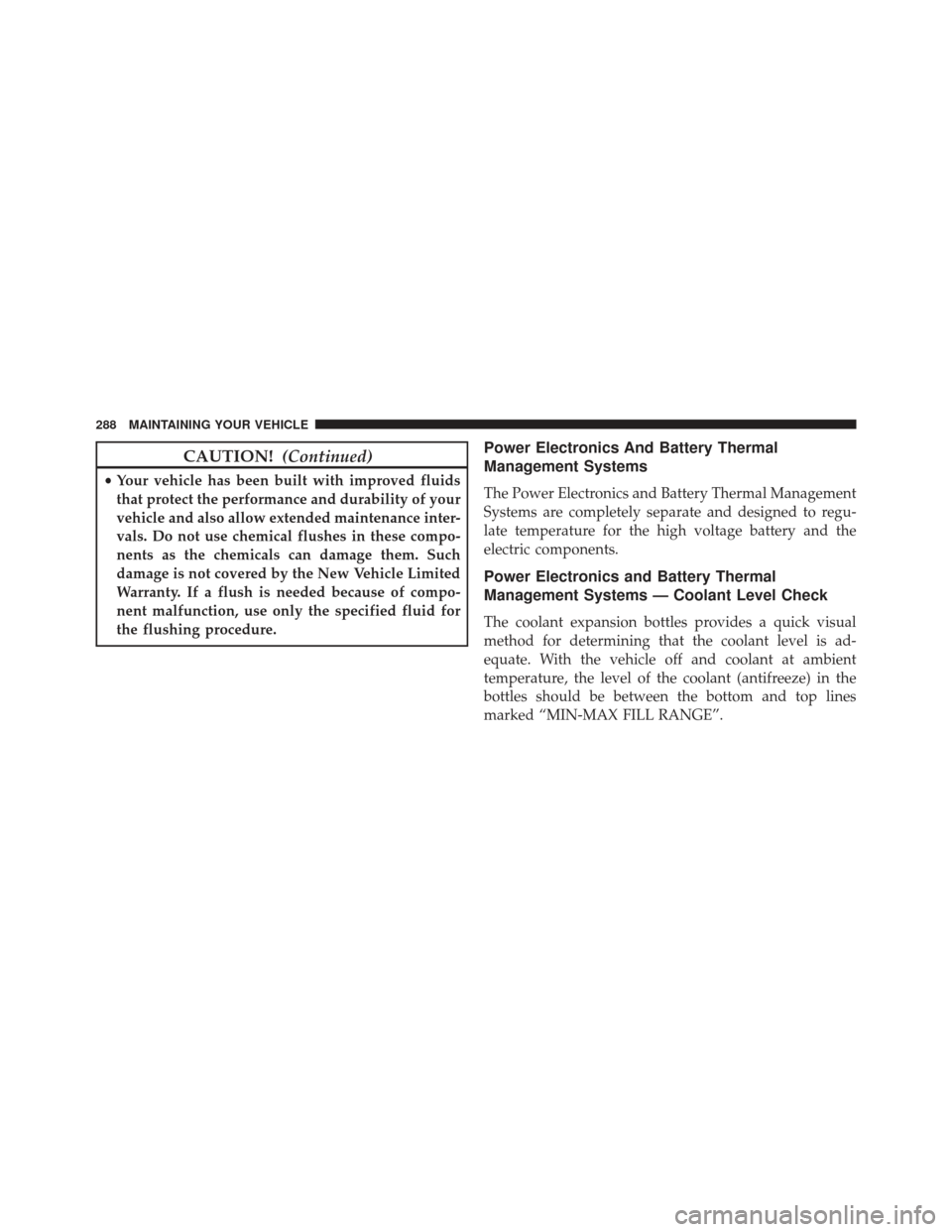
CAUTION!(Continued)
•Your vehicle has been built with improved fluids
that protect the performance and durability of your
vehicle and also allow extended maintenance inter-
vals. Do not use chemical flushes in these compo-
nents as the chemicals can damage them. Such
damage is not covered by the New Vehicle Limited
Warranty. If a flush is needed because of compo-
nent malfunction, use only the specified fluid for
the flushing procedure.
Power Electronics And Battery Thermal
Management Systems
The Power Electronics and Battery Thermal Management
Systems are completely separate and designed to regu-
late temperature for the high voltage battery and the
electric components.
Power Electronics and Battery Thermal
Management Systems — Coolant Level Check
The coolant expansion bottles provides a quick visual
method for determining that the coolant level is ad-
equate. With the vehicle off and coolant at ambient
temperature, the level of the coolant (antifreeze) in the
bottles should be between the bottom and top lines
marked “MIN-MAX FILL RANGE”.
288 MAINTAINING YOUR VEHICLE
Page 291 of 350
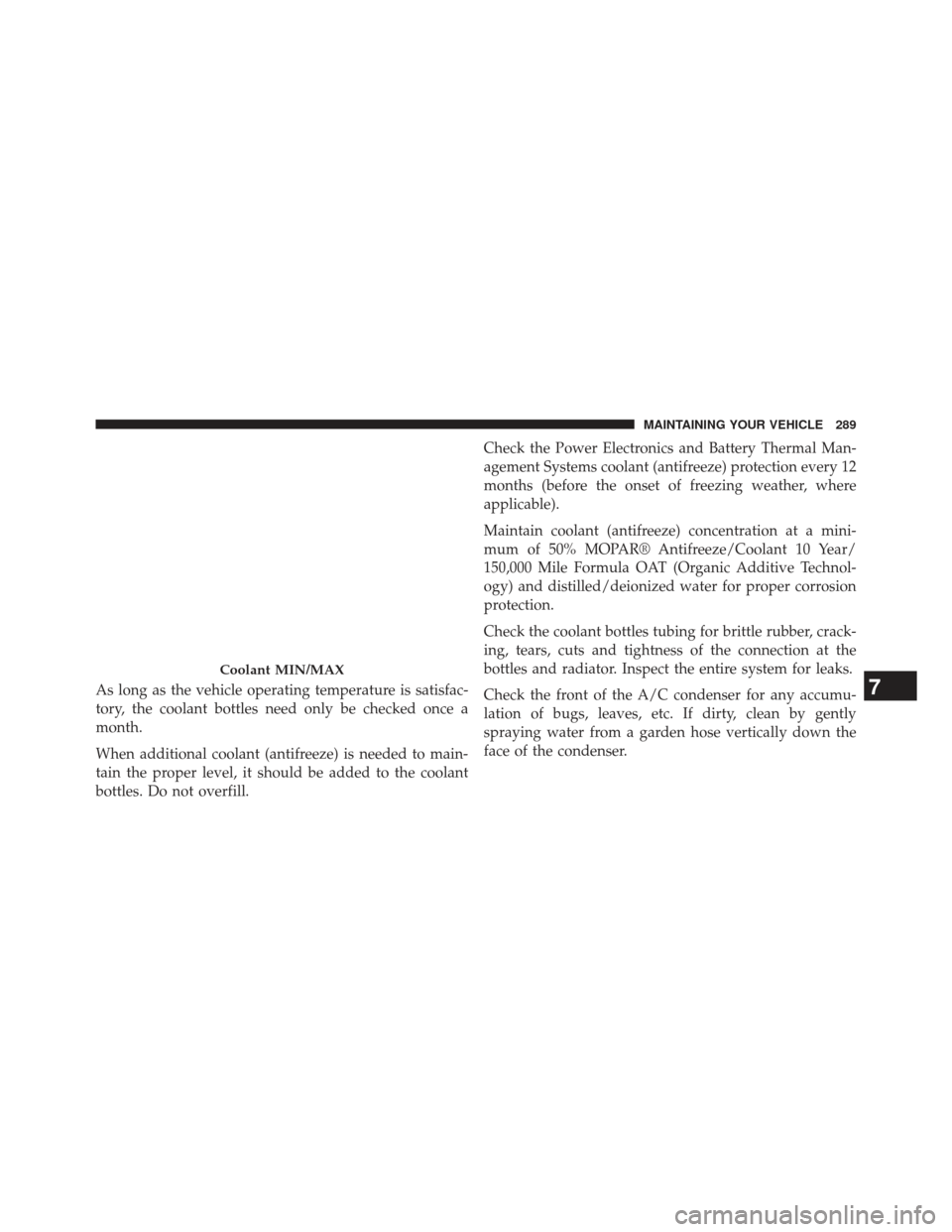
As long as the vehicle operating temperature is satisfac-
tory, the coolant bottles need only be checked once a
month.
When additional coolant (antifreeze) is needed to main-
tain the proper level, it should be added to the coolant
bottles. Do not overfill.Check the Power Electronics and Battery Thermal Man-
agement Systems coolant (antifreeze) protection every 12
months (before the onset of freezing weather, where
applicable).
Maintain coolant (antifreeze) concentration at a mini-
mum of 50% MOPAR® Antifreeze/Coolant 10 Year/
150,000 Mile Formula OAT (Organic Additive Technol-
ogy) and distilled/deionized water for proper corrosion
protection.
Check the coolant bottles tubing for brittle rubber, crack-
ing, tears, cuts and tightness of the connection at the
bottles and radiator. Inspect the entire system for leaks.
Check the front of the A/C condenser for any accumu-
lation of bugs, leaves, etc. If dirty, clean by gently
spraying water from a garden hose vertically down the
face of the condenser.
Coolant MIN/MAX
7
MAINTAINING YOUR VEHICLE 289
Page 292 of 350
NOTE:DO NOT REMOVE THE COOLANT PRESSURE
CAP WHEN THE COOLING SYSTEM IS HOT.WARNING!
You or others can be badly burned by hot coolant
(antifreeze) or steam from your radiator. If you see or
hear steam coming from under the hood, do not open
the hood until the radiator has had time to cool.
Never try to open a cooling system pressure cap
when the radiator is hot.
Power Electronics and Battery Thermal
Management Systems — Cooling Pressure Caps
The caps must be fully tightened to prevent loss of
coolant (antifreeze).
The caps should be inspected and cleaned if there is any
accumulation of foreign material on the sealing surfaces.
290 MAINTAINING YOUR VEHICLE
Page 295 of 350
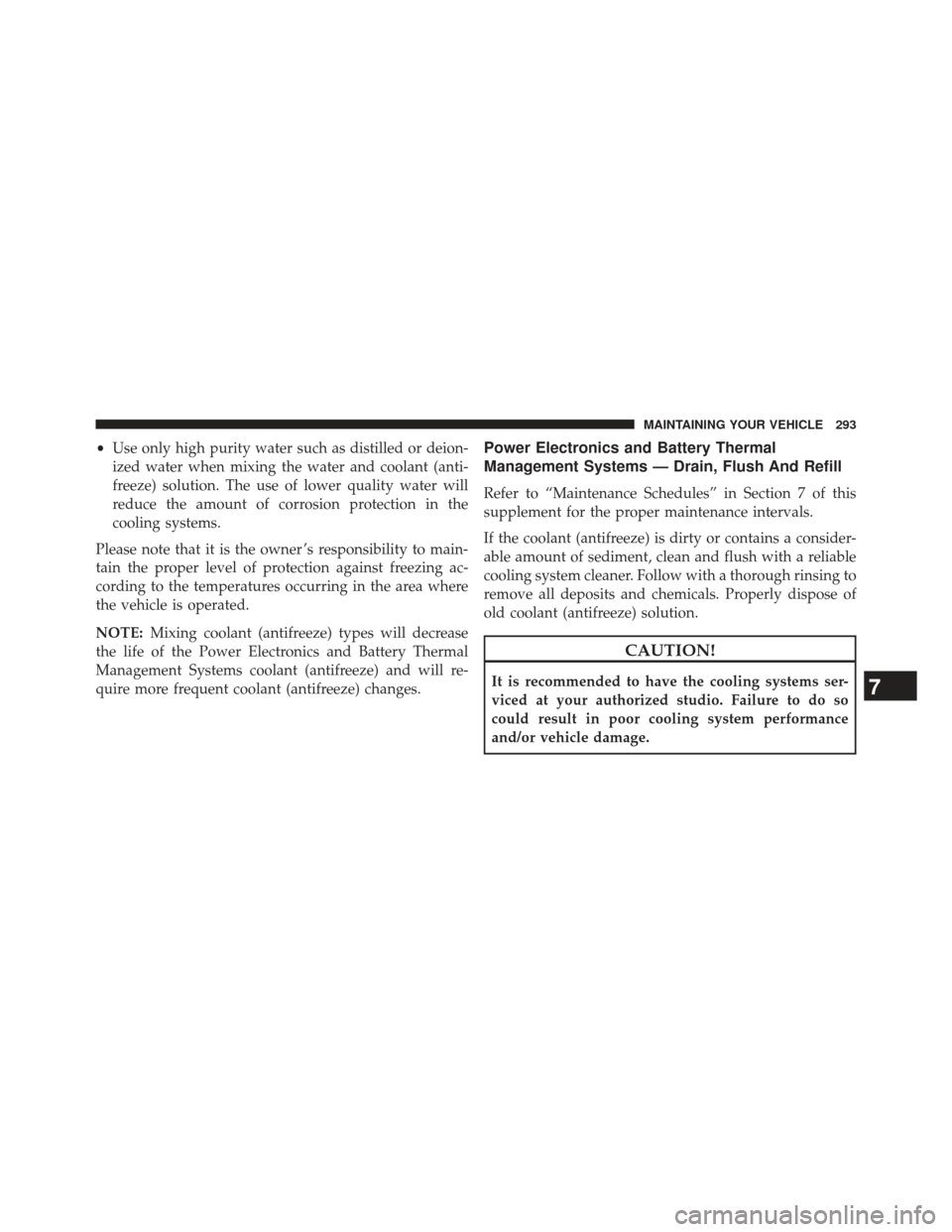
•Use only high purity water such as distilled or deion-
ized water when mixing the water and coolant (anti-
freeze) solution. The use of lower quality water will
reduce the amount of corrosion protection in the
cooling systems.
Please note that it is the owner ’s responsibility to main-
tain the proper level of protection against freezing ac-
cording to the temperatures occurring in the area where
the vehicle is operated.
NOTE: Mixing coolant (antifreeze) types will decrease
the life of the Power Electronics and Battery Thermal
Management Systems coolant (antifreeze) and will re-
quire more frequent coolant (antifreeze) changes.Power Electronics and Battery Thermal
Management Systems — Drain, Flush And Refill
Refer to “Maintenance Schedules” in Section 7 of this
supplement for the proper maintenance intervals.
If the coolant (antifreeze) is dirty or contains a consider-
able amount of sediment, clean and flush with a reliable
cooling system cleaner. Follow with a thorough rinsing to
remove all deposits and chemicals. Properly dispose of
old coolant (antifreeze) solution.
CAUTION!
It is recommended to have the cooling systems ser-
viced at your authorized studio. Failure to do so
could result in poor cooling system performance
and/or vehicle damage.7
MAINTAINING YOUR VEHICLE 293
Page 296 of 350

Disposal Of Used Power Electronics and Battery
Thermal Management Systems Coolant
Used antifreeze is a regulated substance requiring proper
disposal. Check with your local authorities to determine
the disposal rules for your community. To prevent inges-
tion by animals or children, do not store antifreeze in
open containers or allow it to remain in puddles on the
ground. If ingested by a child, contact a physician
immediately. Clean up any ground spills immediately.
Points To Remember
If an examination of your underhood compartment
shows no evidence of cooler or hose leaks, the vehicle
may be safely driven.
•Do not overfill the coolant recovery bottles. •
Check coolant (antifreeze) freeze point in the coolant
recovery bottles. If coolant (antifreeze) needs to be
added, contents of coolant recovery bottles must also
be protected against freezing.
• If frequent coolant (antifreeze) additions are required,
or if the level in the coolant recovery bottles does not
drop when the engine cools, the cooling system should
be pressure tested for leaks.
• Maintain coolant (antifreeze) concentration at 50%
OAT coolant (antifreeze) (minimum) and distilled/
deionized water for proper corrosion protection of
your engine which contains aluminum components.
• Make sure that the coolant control systems recovery
bottles overflow hoses are not kinked or obstructed.
• Keep the front of the coolant control systems clean. If
your vehicle is equipped with air conditioning, keep
the front of the condenser clean.
294 MAINTAINING YOUR VEHICLE
Page 297 of 350
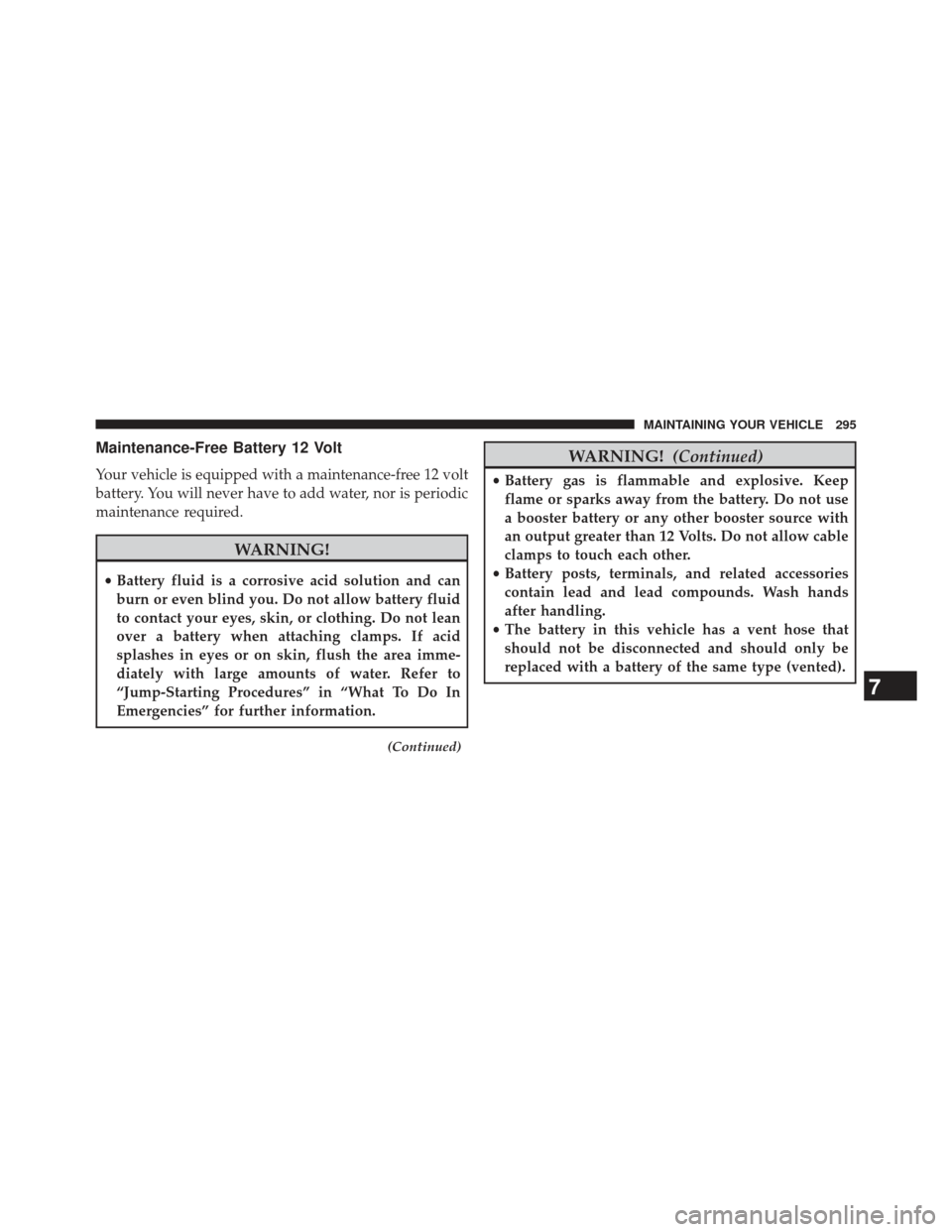
Maintenance-Free Battery 12 Volt
Your vehicle is equipped with a maintenance-free 12 volt
battery. You will never have to add water, nor is periodic
maintenance required.
WARNING!
•Battery fluid is a corrosive acid solution and can
burn or even blind you. Do not allow battery fluid
to contact your eyes, skin, or clothing. Do not lean
over a battery when attaching clamps. If acid
splashes in eyes or on skin, flush the area imme-
diately with large amounts of water. Refer to
“Jump-Starting Procedures” in “What To Do In
Emergencies” for further information.
(Continued)
WARNING! (Continued)
•Battery gas is flammable and explosive. Keep
flame or sparks away from the battery. Do not use
a booster battery or any other booster source with
an output greater than 12 Volts. Do not allow cable
clamps to touch each other.
• Battery posts, terminals, and related accessories
contain lead and lead compounds. Wash hands
after handling.
• The battery in this vehicle has a vent hose that
should not be disconnected and should only be
replaced with a battery of the same type (vented).
7
MAINTAINING YOUR VEHICLE 295
Page 298 of 350
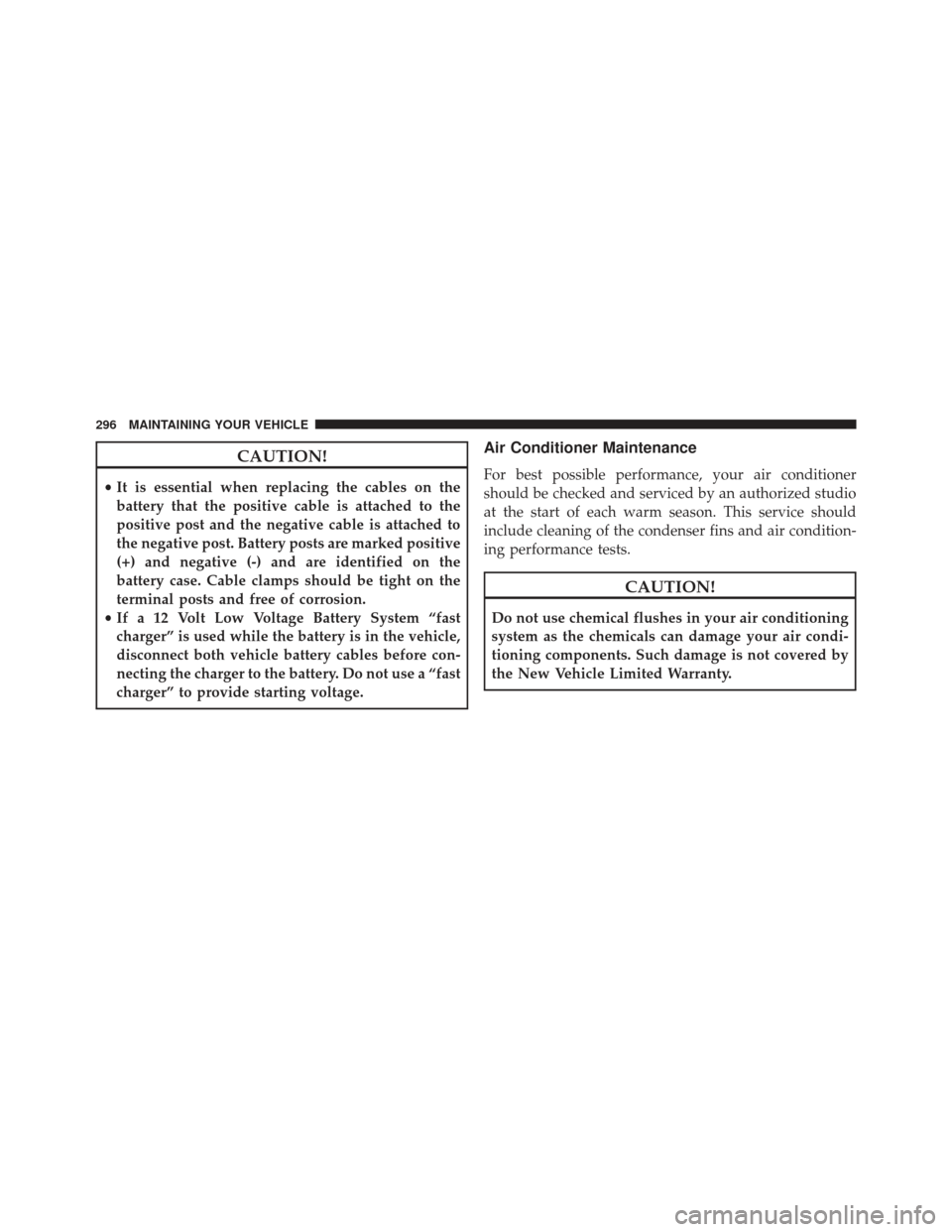
CAUTION!
•It is essential when replacing the cables on the
battery that the positive cable is attached to the
positive post and the negative cable is attached to
the negative post. Battery posts are marked positive
(+) and negative (-) and are identified on the
battery case. Cable clamps should be tight on the
terminal posts and free of corrosion.
• If a 12 Volt Low Voltage Battery System “fast
charger” is used while the battery is in the vehicle,
disconnect both vehicle battery cables before con-
necting the charger to the battery. Do not use a “fast
charger” to provide starting voltage.
Air Conditioner Maintenance
For best possible performance, your air conditioner
should be checked and serviced by an authorized studio
at the start of each warm season. This service should
include cleaning of the condenser fins and air condition-
ing performance tests.
CAUTION!
Do not use chemical flushes in your air conditioning
system as the chemicals can damage your air condi-
tioning components. Such damage is not covered by
the New Vehicle Limited Warranty.
296 MAINTAINING YOUR VEHICLE
Page 315 of 350
Power Distribution Center (PDC) #2
The Power Distribution Center #2 is located next to the
battery in the underhood compartment. To access the
fuses, pull the release tabs and remove the cover.
Cavity MaxiFuseMini
Fuse Description
FPT9 15 Amp
BlueBattery Pack Con-
trol Module
(BPCM)
Power Inverter
Module (PIM)
FPT13 10 Amp
Red EAC (AC Com-
pressor)
On Board Charg-
ing Module
(OBCM)
FPT16 5 Amp
Ta n Intelligent Battery
Sensor (IBS)
FPT17 10 Amp
Red EAC (AC Com-
pressor)
Radiator Fan
PDC #2
7
MAINTAINING YOUR VEHICLE 313